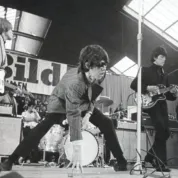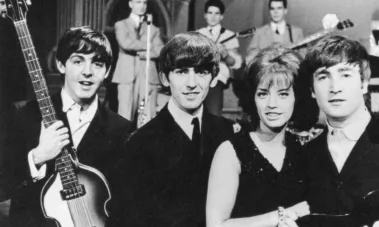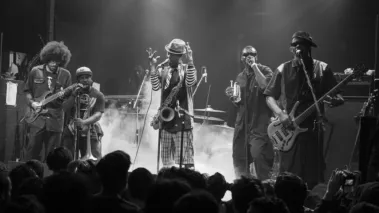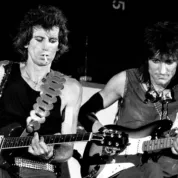
Electric guitar riffs, pounding drum beats, and powerful vocals are the hallmark sounds of rock 'n' roll, rebellious rock genre characteristics that's left a powerful mark on culture worldwide. But why did rock become such a juggernaut of musical expression, and not the jazz or blues which it emerged from? What foundational differences made it stand out and so appealing? From its inception in the post-World War II era to its evolution through modern technological changes, this article outlines the history rock as a genre, and the rock music characteristics that have allowed it endure as a top 3 genre for so many years.
What is Rock Music?
To fully understand the characteristics of rock music and what has made the genre endure as a top 3 genre for so long, its important to first know the history of rock music. Over the past 70+ years, it's been greatly influenced by changes in society, creative breakthroughs, and major tech upgrades. Following its journey from the noisy beginnings of Little Richard, to the variety of innovative forms we see today, allows us to understand what makes rock what it is. It's a must-know story for anyone who wants to truly embrace rock genre characteristics, or answer questions like 'what is rock music?' or 'what is the definition of rock music?'
History of Rock Music

Pre-Rock Era and the Birth of Rock 'n' Roll
Time Period: 1940s and 1950s
Before rock music exploded onto the scene, the musical landscape was a blend of jazz, blues, and big band sounds. Crooners like Frank Sinatra ruled the airwaves, and the nation was generally more conservative. But post-World War II, a sense of rebellion and freedom began to stir, especially among young people. They wanted a soundtrack to their lives that mirrored their restless energy. Enter: rock 'n' roll.
Artists like Chuck Berry and Little Richard began to incorporate rhythm and blues elements of rock music, creating an electrifying sound that soon captivated audiences. Songs like "Johnny B. Goode" and "Tutti Frutti" were not just hits; they were cultural markers. Elvis Presley, with his gyrating hips and scandalous dance moves, became the poster boy of this new genre. Noteworthy events like the payola scandal, where DJs were bribed to play certain songs, made headlines, shaking up the music industry.
The British Invasion, Punk and the Birth of Heavy Metal
Time Period: 1960s and 1970s
The History of Rock Music took an international turn as British bands like The Beatles and The Rolling Stones invaded American soil. Rock music quickly evolved, sprouting various sub-genres like psychedelic rock, personified by bands like Pink Floyd and The Doors. Woodstock, a music festival that celebrated peace, love, and music, became one of the most iconic events in rock history.

Towards the latter part of the '70s, hard rock and punk started to emerge. Artists like Led Zeppelin and Black Sabbath created heavier rock music characteristics, and an edgier sound. Punk rock, with bands like The Ramones and The Sex Pistols, became the anthem of the anti-establishment, challenging societal norms and political systems.
MTV Culture, Hair Metal, and Grunge
Time Period: 1980s and 1990s
The 1980s roared into life with the launch of MTV, forever linking rock's sound and look. Hard rock bands like AC/DC and Guns N' Roses sported leather jackets and big hair, setting the tone for rebellious youth culture. Glam rock acts like Bon Jovi and Mötley Crüe added theatrical flair, their anthemic tunes filling arenas and creating societal debates over rock's excesses. Events like Live Aid in 1985 highlighted rock's societal influence, morphing it from a genre into a cultural movement.
The 1990s pivoted sharply, as grunge bands like Nirvana and Pearl Jam stripped away the 80s' glamour to expose a raw, angsty underbelly that resonated with a disillusioned generation. Alternative rock also emerged, with bands like Radiohead and R.E.M. offering a more experimental approach. Fashion followed suit, trading leather for plaid shirts and ripped jeans, and events like Woodstock '94 became flashpoints for debates over the genre's commercialization.

The boundaries of rock genre characteristics stretched further with collaborations like Public Enemy and Anthax "Bring the Noise" breaking down racial and musical barriers, and setting up new rock-rap subgenres. The blend of rock with pop, hip-hop and R&B recording techniques set the stage for the digital innovations that would dominate the 2000s. Despite these changes, the foundational characteristics of rock music have largely remained consistent, showcasing its resilience and enduring impact.
Indie, the Digital Age, and Social Media
Time Period: 2000s
As we entered the new millennium, the "History of Rock Music" saw a decline in mainstream popularity, but it was far from dead. Indie rock bands like The Strokes and emo bands like My Chemical Romance represented the genre’s new directions. The advent of the internet drastically altered how music was distributed and consumed. Social media platforms allowed artists to connect directly with fans. Imagine Dragons broke into the mainstream, while bands like King Gizzard gained cult followings. Social media sensations like Jax redefined how success in the music industry could be achieved.
Despite these seismic shifts in the history of the rock genre, the characteristics of rock music have remained surprisingly consistent. Whether you’re an artist on the rise, a hardcore fan, or simply wondering 'what is rock music?', learning its characteristics will help you appreciate the foundational elements of rock music that make it what it is today.
The 5 Characteristics of Rock Music
Rock music characteristics form the foundation for both musicians and fans to thrive in the genre. Surprisingly, throughout rock 'n' roll's long 80-year journey, its core characteristics haven't changed that much. From the beat that gets your head nodding to its cultural impact, the 5 characteristics of rock music offer a full picture of what makes this genre unique. They've allowed rock music to stand the test of time and continue to connect with all of us on so many levels.
1. The Beat and Rhythm

When you think of rock music, you often feel a thumping in your chest—a backbeat that sets the tone and makes the genre instantly recognizable. The 4/4 time signature is like the heartbeat of rock; it's what you tap your foot to, whether you're in a crowded arena or listening through headphones. This backbone allows for a wide range of tempos, often between 100 to 140 beats per minute (bpm). But why is this particular range so common? It's because these tempos match up with our physiological rhythms, like heart rate and walking pace, making it natural to engage with the characteristics of rock music.
Let's talk about the drummers, who are like the unsung heroes of rock music. In the early days of rock 'n' roll, drumming was mostly about keeping time. However, as rock evolved, drummers like Keith Moon and John Bonham started taking liberties with the 4/4 structure, adding intricate fills and polyrhythms that expanded the rhythmic landscape of rock. The evolution of drumming techniques greatly influenced rock's beat and rhythm, moving from a time-keeping function to an art form in its own right.
So, how did we get from a basic 4/4 beat to the diverse rhythms in modern rock? It's through a combination of cultural influence and technological innovation. Drum kits evolved to include cymbals, double bass drums, and even digital pads, broadening the range of sounds and rhythms that could be produced. In addition, genres like jazz and blues left their mark, leading to a more syncopated and varied beat in subgenres like progressive rock and alternative.
Lastly, let's touch upon the role of rhythm guitars and bass have had on rock music characteristics and the fundamental elements of rock music. They fill in the spaces between the drum beats, creating a layered rhythmic texture that gives rock its distinct 'groove.' Whether it's the jangly rhythm guitar in a Beatles song or the deep, punchy bass in a Led Zeppelin track, these elements of rock music interact with the drums to create a complex rhythmic mosaic that’s compelling and uniquely rock.
2. Electric Instruments and Drum Kits

Rock music is to electric guitars what peanut butter is to jelly—they just belong together. But it’s not just the guitar; we’ve got the bass guitar and the keys adding layers of melodies and rhythms that make rock such a full-sounding genre. Often, these instruments go through amplifiers that add a layer of distortion, providing the gritty sound that is synonymous with the characteristics of rock music.
In the beginning, electric guitars brought a new level of expressiveness to music, creating a fuller sound that could fill larger venues. Les Paul and Leo Fender revolutionized the guitar world with their electric designs in the 1950s, enabling artists like Chuck Berry to pioneer rock music. Electric bass guitars soon followed suit, with models like the Fender Precision Bass transforming the role of the bassist from a background player to a key member of the ensemble.
Keyboards and synthesizers came into play later but left an indelible mark on rock music characteristics. Progressive rock bands like Pink Floyd used organs and synthesizers to add texture and complexity to their sound. In the '80s, synth-rock bands like The Cars and Duran Duran took this to a new level, using electronic instruments to create rock music that was modern and incredibly danceable.
And then, of course, there's the drum kit—a conglomerate of snare, bass drum, toms, hi-hats, and cymbals. These aren't just rhythm-keeping devices; they're an orchestra in themselves. Drum kits got complex with more pieces added, allowing drummers to create an array of sounds that could range from the thunderous to the tinkling. The full drum kit became essential in creating the layered, complex rhythms that are a hallmark of rock music.
3. Vocal-Centric Song Structure

Rock music characteristics extend beyond the instruments; it's also about the message, the lyrics, and the vocals. Often, a rock band is only as good as its frontman—or woman. From legends like Freddie Mercury to modern icons like Billie Joe Armstrong, the vocals in rock music are central to the genre's identity. But it's not just about hitting those high notes; it's about telling a story.
The common structure for rock songs is verse-chorus, sometimes interspersed with a bridge or an instrumental solo. Why this structure? It lends itself to storytelling. Verses set the scene, choruses provide the emotional climax, and bridges offer a new perspective. The narrative arc in this structure makes the characteristics of rock music compelling and relatable.
Remember those rock ballads or power anthems where the instrumental takes a backseat? Unlike in other genres where instrumentals can dominate, rock focuses on lyrics. The words can range from politically charged to deeply personal, and they often drive the song just as much as any guitar riff or drum beat.
Let's also talk about those iconic instrumental solos, often a guitar or drum solo, that break the song structure. These aren't just musical self-indulgence; they're a vital part of the narrative, adding an emotional depth or technical brilliance that words can't convey. From Jimi Hendrix’s explosive guitar solos to Neil Peart’s intricate drumming, these moments add another layer to the storytelling, capturing the audience's attention and often becoming the highlight of live performances.
4. Body Language

You can often tell a rock performance by the energy on stage. Body language is a critical rock music characteristic, conveying a sense of excitement, and at times even aggression. Think about how Mick Jagger struts across the stage or how Angus Young of AC/DC hops around in a schoolboy outfit. This wasn't just showmanship; it was a counter-cultural statement against the subdued, "appropriate" music that their parents listened to.
But as rock became mainstream, the counter-culture changed its tune. In the '90s and 2000s, the grunge and emo scenes brought a different kind of body language—laid back, sometimes even appearing bored or melancholic. It was as if the more rock tried to fit in, the more it had to stand out. This change reflected in bands like Nirvana, who carried a kind of anti-charisma. Their body language screamed, "We're not trying to impress anyone," which ironically made them even more compelling.
5. Cultural Influence

Rock music hasn't just shaped our playlists; it's shaped our world. When you think of rock 'n' roll, you think of leather jackets, band t-shirts, ripped jeans—the fashion choices that made you stand apart. But it's more than just clothes; rock has had a profound impact on lifestyle choices, social issues, and even politics, making cultural influence one of the most impactful rock music characteristics.
In the '60s and '70s, rock was the soundtrack to the civil rights movement and anti-war protests. Bands like Crosby, Stills, Nash & Young and The Who weren't just musicians; they were spokespeople for a generation that wanted change. Even today, rock continues to be a voice for social issues, used in campaigns, protests, and awareness-raising events.
Rock has also impacted our day-to-day life in ways we don't even realize. The "sex, drugs, and rock 'n' roll" lifestyle, while often criticized, became a form of rebellion and self-expression. It brought issues like substance abuse and mental health into the public conversation, leading to more awareness and, in some cases, more acceptance.
So, whether you're headbanging to a heavy metal track or swaying to a soft rock ballad, you're not just enjoying a genre; you're part of a culture, a history, a movement. Rock isn't just music; it's a way of life.
The Timeless Appeal of a Counter-Cultural Genre
You should now be better equipped to answer the questions 'what is rock music?' and 'what is the definition of rock music?' The history of rock 'n' roll has been a catalyst for change, from its birth in the 1950s, to its rebellious teen years during the British Invasion and on Music Television, to its continued transformation in the modern digital age. Rock 'n' Roll is more than just a genre; it's a language, a lifestyle, and a lens through which many of us see the world. The characteristics of rock music have remained consistent throughout its history, even as the genre has splintered into countless subgenres. Knowing the history of rock music, and the evolution of the elements of rock music is essential for rock musicians shaping their future, as well as the fans who identify with its songs. The next time you hear a screeching rock guitar solo or its fiery lyrics, remember the history of rock music and the characteristics of rock music. As that is what has separated it from other genres, and made it a long-lasting and dominant staple in the music industry.







Leave a Reply!
Read my "Definition of Classic Rock" to get how it influenced all modern Rock bands.
It's actually a cool and helpful piece of information. I'm happy that you simply shared this useful info with us. Please keep us informed like this. Thank you for sharing.